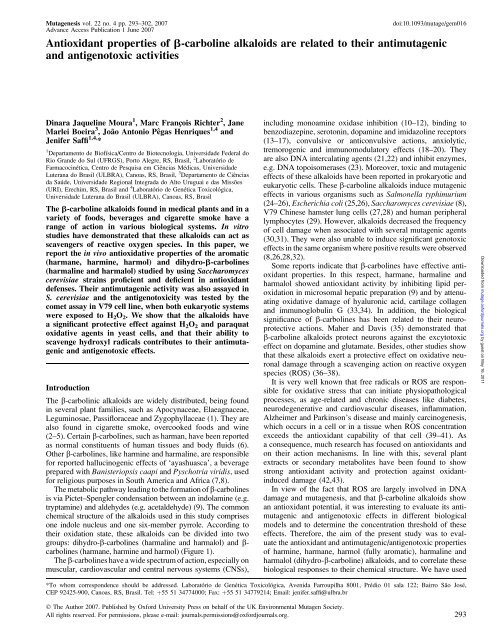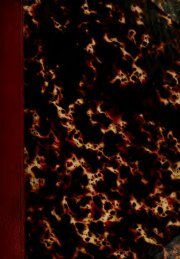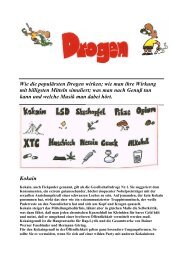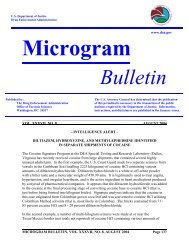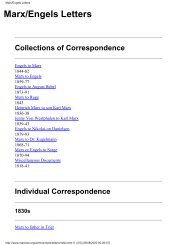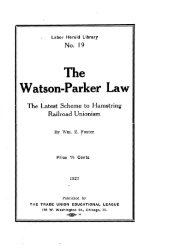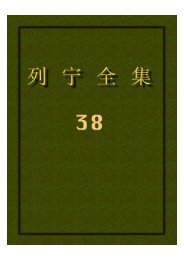MOURA Dinara Jaqueline et al.
MOURA Dinara Jaqueline et al.
MOURA Dinara Jaqueline et al.
You also want an ePaper? Increase the reach of your titles
YUMPU automatically turns print PDFs into web optimized ePapers that Google loves.
Mutagenesis vol. 22 no. 4 pp. 293–302, 2007 doi:10.1093/mutage/gem016<br />
Advance Access Publication 1 June 2007<br />
Antioxidant properties of b-carboline <strong>al</strong>k<strong>al</strong>oids are related to their antimutagenic<br />
and antigenotoxic activities<br />
<strong>Dinara</strong> <strong>Jaqueline</strong> Moura 1 , Marc Francxois Richter 2 , Jane<br />
Marlei Boeira 3 , João Antonio Pêgas Henriques 1,4 and<br />
Jenifer Saffi 1,4, *<br />
1<br />
Departamento de Biofísica/Centro de Biotecnologia, Universidade Feder<strong>al</strong> do<br />
Rio Grande do Sul (UFRGS), Porto Alegre, RS, Brasil, 2 Laboratório de<br />
Farmacocinética, Centro de Pesquisa em Ciências Médicas, Universidade<br />
Luterana do Brasil (ULBRA), Canoas, RS, Brasil, 3 Departamento de Ciências<br />
da Saúde, Universidade Region<strong>al</strong> Integrada do Alto Uruguai e das Missões<br />
(URI), Erechim, RS, Brasil and 4 Laboratório de Genética Toxicológica,<br />
Universidade Luterana do Brasil (ULBRA), Canoas, RS, Brasil<br />
The b-carboline <strong>al</strong>k<strong>al</strong>oids found in medic<strong>al</strong> plants and in a<br />
vari<strong>et</strong>y of foods, beverages and cigar<strong>et</strong>te smoke have a<br />
range of action in various biologic<strong>al</strong> systems. In vitro<br />
studies have demonstrated that these <strong>al</strong>k<strong>al</strong>oids can act as<br />
scavengers of reactive oxygen species. In this paper, we<br />
report the in vivo antioxidative properties of the aromatic<br />
(harmane, harmine, harmol) and dihydro-b-carbolines<br />
(harm<strong>al</strong>ine and harm<strong>al</strong>ol) studied by using Saccharomyces<br />
cerevisiae strains proficient and deficient in antioxidant<br />
defenses. Their antimutagenic activity was <strong>al</strong>so assayed in<br />
S. cerevisiae and the antigenotoxicity was tested by the<br />
com<strong>et</strong> assay in V79 cell line, when both eukaryotic systems<br />
were exposed to H2O2. We show that the <strong>al</strong>k<strong>al</strong>oids have<br />
a significant protective effect against H2O2 and paraquat<br />
oxidative agents in yeast cells, and that their ability to<br />
scavenge hydroxyl radic<strong>al</strong>s contributes to their antimutagenic<br />
and antigenotoxic effects.<br />
Introduction<br />
The b-carbolinic <strong>al</strong>k<strong>al</strong>oids are widely distributed, being found<br />
in sever<strong>al</strong> plant families, such as Apocynaceae, Elaeagnaceae,<br />
Leguminosae, Passifloraceae and Zygophyllaceae (1). They are<br />
<strong>al</strong>so found in cigar<strong>et</strong>te smoke, overcooked foods and wine<br />
(2–5). Certain b-carbolines, such as harman, have been reported<br />
as norm<strong>al</strong> constituents of human tissues and body fluids (6).<br />
Other b-carbolines, like harmine and harm<strong>al</strong>ine, are responsible<br />
for reported h<strong>al</strong>lucinogenic effects of ‘ayashuasca’, a beverage<br />
prepared with Banisteriopsis caapi and Pyschotria viridis, used<br />
for religious purposes in South America and Africa (7,8).<br />
The m<strong>et</strong>abolic pathway leading to the formation of b-carbolines<br />
is via Pict<strong>et</strong>–Spengler condensation b<strong>et</strong>ween an indolamine (e.g.<br />
tryptamine) and <strong>al</strong>dehydes (e.g. ac<strong>et</strong><strong>al</strong>dehyde) (9). The common<br />
chemic<strong>al</strong> structure of the <strong>al</strong>k<strong>al</strong>oids used in this study comprises<br />
one indole nucleus and one six-member pyrrole. According to<br />
their oxidation state, these <strong>al</strong>k<strong>al</strong>oids can be divided into two<br />
groups: dihydro-b-carbolines (harm<strong>al</strong>ine and harm<strong>al</strong>ol) and bcarbolines<br />
(harmane, harmine and harmol) (Figure 1).<br />
The b-carbolines have a wide spectrum of action, especi<strong>al</strong>ly on<br />
muscular, cardiovascular and centr<strong>al</strong> nervous systems (CNSs),<br />
including monoamine oxidase inhibition (10–12), binding to<br />
benzodiazepine, serotonin, dopamine and imidazoline receptors<br />
(13–17), convulsive or anticonvulsive actions, anxiolytic,<br />
tremorogenic and immunomodulatory effects (18–20). They<br />
are <strong>al</strong>so DNA interc<strong>al</strong>ating agents (21,22) and inhibit enzymes,<br />
e.g. DNA topoisomerases (23). Moreover, toxic and mutagenic<br />
effects of these <strong>al</strong>k<strong>al</strong>oids have been reported in prokaryotic and<br />
eukaryotic cells. These b-carboline <strong>al</strong>k<strong>al</strong>oids induce mutagenic<br />
effects in various organisms such as S<strong>al</strong>monella typhimurium<br />
(24–26), Escherichia coli (25,26), Saccharomyces cerevisiae (8),<br />
V79 Chinese hamster lung cells (27,28) and human peripher<strong>al</strong><br />
lymphocytes (29). However, <strong>al</strong>k<strong>al</strong>oids decreased the frequency<br />
of cell damage when associated with sever<strong>al</strong> mutagenic agents<br />
(30,31). They were <strong>al</strong>so unable to induce significant genotoxic<br />
effects in the same organism where positive results were observed<br />
(8,26,28,32).<br />
Some reports indicate that b-carbolines have effective antioxidant<br />
properties. In this respect, harmane, harm<strong>al</strong>ine and<br />
harm<strong>al</strong>ol showed antioxidant activity by inhibiting lipid peroxidation<br />
in microsom<strong>al</strong> hepatic preparation (9) and by attenuating<br />
oxidative damage of hy<strong>al</strong>uronic acid, cartilage collagen<br />
and immunoglobulin G (33,34). In addition, the biologic<strong>al</strong><br />
significance of b-carbolines has been related to their neuroprotective<br />
actions. Maher and Davis (35) demonstrated that<br />
b-carboline <strong>al</strong>k<strong>al</strong>oids protect neurons against the excytotoxic<br />
effect on dopamine and glutamate. Besides, other studies show<br />
that these <strong>al</strong>k<strong>al</strong>oids exert a protective effect on oxidative neuron<strong>al</strong><br />
damage through a scavenging action on reactive oxygen<br />
species (ROS) (36–38).<br />
It is very well known that free radic<strong>al</strong>s or ROS are responsible<br />
for oxidative stress that can initiate physiopathologic<strong>al</strong><br />
processes, as age-related and chronic diseases like diab<strong>et</strong>es,<br />
neurodegenerative and cardiovascular diseases, inflammation,<br />
Alzheimer and Parkinson’s disease and mainly carcinogenesis,<br />
which occurs in a cell or in a tissue when ROS concentration<br />
exceeds the antioxidant capability of that cell (39–41). As<br />
a consequence, much research has focused on antioxidants and<br />
on their action mechanisms. In line with this, sever<strong>al</strong> plant<br />
extracts or secondary m<strong>et</strong>abolites have been found to show<br />
strong antioxidant activity and protection against oxidantinduced<br />
damage (42,43).<br />
In view of the fact that ROS are largely involved in DNA<br />
damage and mutagenesis, and that b-carboline <strong>al</strong>k<strong>al</strong>oids show<br />
an antioxidant potenti<strong>al</strong>, it was interesting to ev<strong>al</strong>uate its antimutagenic<br />
and antigenotoxic effects in different biologic<strong>al</strong><br />
models and to d<strong>et</strong>ermine the concentration threshold of these<br />
effects. Therefore, the aim of the present study was to ev<strong>al</strong>uate<br />
the antioxidant and antimutagenic/antigenotoxic properties<br />
of harmine, harmane, harmol (fully aromatic), harm<strong>al</strong>ine and<br />
harm<strong>al</strong>ol (dihydro-b-carboline) <strong>al</strong>k<strong>al</strong>oids, and to correlate these<br />
biologic<strong>al</strong> responses to their chemic<strong>al</strong> structure. We have used<br />
*To whom correspondence should be addressed. Laboratório de Genética Toxicológica, Avenida Farroupilha 8001, Prédio 01 s<strong>al</strong>a 122; Bairro São José,<br />
CEP 92425-900, Canoas, RS, Brasil. Tel: þ55 51 34774000; Fax: þ55 51 34779214; Email: jenifer.saffi@ulbra.br<br />
Ó The Author 2007. Published by Oxford University Press on beh<strong>al</strong>f of the UK Environment<strong>al</strong> Mutagen Soci<strong>et</strong>y.<br />
All rights reserved. For permissions, please e-mail: journ<strong>al</strong>s.permissions@oxfordjourn<strong>al</strong>s.org. 293<br />
Downloaded from<br />
mutage.oxfordjourn<strong>al</strong>s.org by guest on May 16, 2011
D. J. Moura <strong>et</strong> <strong>al</strong>.<br />
H2O2 and paraquat to induce oxidative damage in S. cerevisiae<br />
strains defective in sever<strong>al</strong> antioxidant defenses. We have<br />
<strong>al</strong>so ev<strong>al</strong>uated the mutagenicity and antimutagenicity of the<br />
<strong>al</strong>k<strong>al</strong>oids using the yeast strain N123, as well as their protective<br />
effect against oxidative DNA damage, verified by the com<strong>et</strong><br />
assay in a culture of permanent lung fibroblast cell line derived<br />
from Chinese hamsters.<br />
Materi<strong>al</strong>s and m<strong>et</strong>hods<br />
Chemic<strong>al</strong>s<br />
The <strong>al</strong>k<strong>al</strong>oids harmane (CAS 21655-84-5), harmine (CAS 343-27-1), harmol<br />
(CAS 149022-16-2), harm<strong>al</strong>ine (CAS 6027-98-1) and harm<strong>al</strong>ol (CAS 6028-07-5)<br />
hydrochlorides, H2O2, paraquat (m<strong>et</strong>hyl viologen), m<strong>et</strong>hyl m<strong>et</strong>hanesulfonate<br />
(MMS), 4-nitroquinoline-N-oxide (4-NQO), hypoxanthine, xanthine oxidase and<br />
s<strong>al</strong>icylic acid were obtained from Sigma (St Louis, MO, USA). Dulbecco’s<br />
modified Eagle’s medium (DMEM), f<strong>et</strong><strong>al</strong> bovine serum (FBS), trypsin–<strong>et</strong>hylenediamine<br />
t<strong>et</strong>raac<strong>et</strong>ic acid (EDTA), L-glutamine, antibiotics and trypan blue<br />
were purchased from Gibco BRL (Grand Island, NY, USA). Low-melting<br />
point agarose (LMA) and agarose were obtained from Invitrogen (Carlsbad, CA,<br />
USA). Yeast extract, bacto-peptone and bacto-agar were obtained from Difco<br />
Laboratories (D<strong>et</strong>roit, MI, USA). All others reagents were of an<strong>al</strong>ytic<strong>al</strong> grade.<br />
For treatment of cells, 5 mg/ml stock solutions of the <strong>al</strong>k<strong>al</strong>oids were prepared<br />
immediately prior to use. Harmine was dissolved in distilled water and<br />
harman, harmol, harm<strong>al</strong>ine and harm<strong>al</strong>ol were dissolved in 5% dim<strong>et</strong>hylsulf-<br />
Fig. 1. Chemic<strong>al</strong> structure of the b-carboline <strong>al</strong>k<strong>al</strong>oids. (A) Aromatic<br />
b-carboline. (B) dihydro-b-carbolines.<br />
Table I. Saccharomyces cerevisiae strains used in this study<br />
oxide (DMSO) and distilled water; the fin<strong>al</strong> concentration of DMSO in the<br />
incubation mixture never exceeds 0.2%. The appropriate concentrations were<br />
obtained by dilution of stock solutions in distilled water. The solvent controls<br />
included in the gen<strong>et</strong>ic tests were found to be negative; 4-NQO, MMS, paraquat<br />
and H2O2 were used as positive control.<br />
Medium and strains of S. cerevisiae<br />
The relevant genotypes of S. cerevisiae strains used in this study are listed in<br />
Table I. Media, solutions and buffers were prepared as previously described<br />
(44). The compl<strong>et</strong>e medium (YPD) containing 0.5% yeast extract, 2% peptone<br />
and 2% glucose was used for routine growth. For plates, the medium was<br />
solidified with 2% bacto-agar. The minim<strong>al</strong> medium (MM) contained 0.67%<br />
yeast nitrogen base without amino acids, 2% glucose and 2% bacto-agar. The<br />
synth<strong>et</strong>ic compl<strong>et</strong>e medium (SC) was MM supplemented with 2 mg adenine,<br />
5 mg lysine, 1 mg histidine, 2 mg leucine, 2 mg m<strong>et</strong>hionine, 2 mg uracil and<br />
2 mg tryptophan per 100 ml MM. For mutagenesis, plates were supplemented<br />
with 60 lg/ml canavanine (SC þ can).<br />
We chose to work in the stationary phase of growth because this resembles<br />
most cells of multicellular organisms in important aspects: (i) most energy<br />
comes from mitochondri<strong>al</strong> respiration, (ii) the cells have left the active cell<br />
cycle and have entered the G 0 phase and (iii) damage accumulates over time<br />
(45,46). The herbicide paraquat, a redox cycling compound, was used to increase<br />
the intracellular flux of superoxide anion (O2 –. ). The appropriate concentrations<br />
of H2O2 and paraquat were d<strong>et</strong>ermined by surviv<strong>al</strong> assay, according<br />
to the differenti<strong>al</strong> sensitivity of each strain. Sub-l<strong>et</strong>h<strong>al</strong> concentration of the<br />
oxidants was used for <strong>al</strong>l subsequent experiments.<br />
Surviv<strong>al</strong> assays in S. cerevisiae strains<br />
Stationary phase cultures of EG103 [wild type (WT)] and mutant isogenic strains,<br />
as well as YPH98 (WT) and the isogenic mutant strain, were obtained by inoculation<br />
of an isolated colony into liquid YPD. To ev<strong>al</strong>uate sensitivity to bcarboline<br />
<strong>al</strong>k<strong>al</strong>oids, cultures were exposed to concentrations varying from 25 to<br />
150 lg/ml and incubated under growth conditions for 1 h in phosphate-buffered<br />
s<strong>al</strong>ine (PBS) at 30°C. Cells were appropriately diluted and plated in triplicate<br />
on solid YPD (2–3 days, 30°C) after colony-forming units were counted.<br />
To verify the antioxidant activity of the <strong>al</strong>k<strong>al</strong>oids, cells were pre-treated in<br />
PBS with non-cytotoxic concentrations of <strong>al</strong>k<strong>al</strong>oids and incubated for 1 h at<br />
30°C. Cells were then washed and treated with paraquat or H2O2 in PBS for<br />
another hour. For surviv<strong>al</strong> d<strong>et</strong>ermination, suitable <strong>al</strong>iquots were plated in<br />
triplicate on solid YPD. Plates were incubated at 30°C for 2–3 days before<br />
counting the colonies. All tests were repeated at least 3-fold, and plating was<br />
carried out in triplicate for each dose.<br />
D<strong>et</strong>ection of forward mutation and potenti<strong>al</strong> antimutagenic activity in<br />
S. cerevisiae<br />
Saccharomyces cerevisiae N123 strain was used for assaying <strong>al</strong>k<strong>al</strong>oid mutagenicity<br />
as well as the protective effect of the <strong>al</strong>k<strong>al</strong>oids against H 2O 2-induced<br />
mutagenesis. This strain was chosen because it is very responsive to H 2O 2induced<br />
mutagenesis due to its low glutathione content (47). A suspension of<br />
2 10 8 cells/ml in the stationary phase, grown in YPD (2% glucose), was<br />
incubated for 1 h at 30°C with various concentrations of <strong>al</strong>k<strong>al</strong>oids in PBS.<br />
Surviv<strong>al</strong> was d<strong>et</strong>ermined on SC (2–5 days, 30°C), and mutation induction<br />
(CAN revertants) on appropriate supplementation media (4–5 days, 30°C).<br />
Forward mutation was measured with the canavanine resistance assay (CAN1can1)<br />
after induction with different treatments. This assay uses a phenotypic<br />
marker, canavanine sensitivity, since WT yeast strains express the arginine<br />
transporter Can1p, which <strong>al</strong>so imports canavanine from the environment and<br />
leads to cell death (48). Thus, mutagen-induced <strong>al</strong>terations in the CAN1 gene<br />
that impair Can1p function<strong>al</strong>ity can increase cell surviv<strong>al</strong> in the presence of<br />
canavanine, when compared to a non-mutagenic cell sample.<br />
Strain Genotype Enzymatic defense lacking Source<br />
EG103 (SOD-WT) MATa leu2D0 his3-D1 trp1-289 ura3-52 None E. Gr<strong>al</strong>la<br />
EG118 (sod1D) Like EG103, except sod1::URA3 Cu–Zn SOD (cytosolic) E. Gr<strong>al</strong>la<br />
EG110 (sod2D) Like EG103, except sod2::TRP1 MnSOD (mitochondri<strong>al</strong>) E. Gr<strong>al</strong>la<br />
EG133 (sod1D sod2D) Like EG103, except sod1::URA3 e sod2::TRP1 All SOD E. Gr<strong>al</strong>la<br />
EG223 (ctt1D) Like EG103, except ctt1::TRP1 Cytosolic cat<strong>al</strong>ase E. Gr<strong>al</strong>la<br />
EG213 (sod1D ctt1D) Like EG103, except sod1::URA3 e ctt1::TRP1 Cu–Zn SOD and cytosolic cat<strong>al</strong>ase E. Gr<strong>al</strong>la<br />
YPH98 (WT) MATa ade2-101 leu2-D1 lys2-801 trp1-D1 ura3-52 None P. Hi<strong>et</strong>er<br />
yap1D Like YPH98 except yap1::URA3 yAP-1 transcription factor M. Grey<br />
N123 MATa his1-7 None, but exhibits low glutathione content J. Henriques<br />
294<br />
Downloaded from<br />
mutage.oxfordjourn<strong>al</strong>s.org by guest on May 16, 2011
For antimutagenic ev<strong>al</strong>uation, the procedure was as follows: cells were<br />
submitted to pre-treatment with non-cytotoxic concentrations of <strong>al</strong>k<strong>al</strong>oids and<br />
incubated for 1 h with shaking at 30°C. Cells were then washed and H 2O 2 was<br />
added. The mixture was further incubated at 30°C for 1 h. After treatment,<br />
appropriate dilutions of cells were plated onto SC plates to d<strong>et</strong>ermine cell<br />
surviv<strong>al</strong>, and 100 ll <strong>al</strong>iquots of cell suspension (2 10 8 cells/ml) were plated<br />
onto SC media supplemented with 60 lg/ml canavanine. Plates were incubated<br />
in the dark at 30°C for 3–5 days before counting the survivors and revertant<br />
colonies. All mutagenicity assays were repeated at least three times, and plating<br />
for each dose was conducted in triplicate.<br />
Com<strong>et</strong> assay using V79 cells<br />
Chinese hamster lung fibroblasts (V79 cells) were cultivated under standard<br />
condition in DMEM supplemented with 10% FBS, 2 mM L-glutamine and<br />
antibiotics (49). Cells were maintained in tissue culture flasks at 37°C in<br />
a humidified atmosphere containing 5% CO 2, and were harvested by treatment<br />
with 0.15% trypsin and 0.08% EDTA in PBS. Cells (2 10 5 ) were seeded into<br />
each flask and cultured 1 day prior to treatment. Alk<strong>al</strong>oids were added to FBSfree<br />
medium to achieve the different designed concentrations, and the cells<br />
were treated for 2 h at 37°C in a humidified atmosphere containing 5% CO2.<br />
Oxidative ch<strong>al</strong>lenge with 0.1 mM H2O2 was carried out for 0.5 h in the dark in<br />
FBS-free medium. The culture flasks were protected from direct light during<br />
treatment with the <strong>al</strong>k<strong>al</strong>oids and H 2O 2.<br />
The <strong>al</strong>k<strong>al</strong>ine com<strong>et</strong> assay was performed as described by Singh <strong>et</strong> <strong>al</strong>. (50)<br />
with minor modifications (51). At the end of treatment, cells were washed with<br />
ice-cold PBS and trypsinized with 100 ll trypsin (0.15%). Immediately<br />
thereafter, 20 ll of cell suspension ( 10 6 cells/ml) were dissolved in 0.75%<br />
LMA and spread on norm<strong>al</strong> agarose point (1%) pre-coated microscope slides.<br />
Cells were ice-cold lysed (2.5 M NaCl, 100 mM EDTA and 10 mM Tris, pH<br />
10.0, with freshly added 1% Triton X-100 and 10% DMSO) for at least 1 h at<br />
4°C in order to remove cellular proteins and membranes, leaving the DNA as<br />
‘nucleoids’. Thereafter, slides were placed in a horizont<strong>al</strong> electrophoresis box,<br />
containing freshly prepared <strong>al</strong>k<strong>al</strong>ine buffer (300 mM NaOH and 1 mM EDTA,<br />
pH 13.0) for 20 min at 4°C in order to <strong>al</strong>low DNA unwinding and expression<br />
of <strong>al</strong>k<strong>al</strong>i-labile sites. An electric current of 300 mA and 25 V (0.90 V/cm) was<br />
applied for 20 min to electrophorese DNA. All the steps above were performed<br />
under yellow light or in the dark in order to prevent addition<strong>al</strong> DNA damage.<br />
Slides were then neutr<strong>al</strong>ized (0.4 M Tris, pH 7.5), stained with silver nitrate as<br />
described by Nadin <strong>et</strong> <strong>al</strong>. (52) and an<strong>al</strong>yzed using an optic microscope. Images<br />
of 100 randomly selected cells (50 cells from each of two replicate slides) were<br />
an<strong>al</strong>yzed per group. Cells were <strong>al</strong>so scored visu<strong>al</strong>ly into five classes, according<br />
to tail size (from undamaged, 0, to maxim<strong>al</strong>ly damaged, 4).<br />
Internation<strong>al</strong> guidelines and recommendations for the com<strong>et</strong> assay consider<br />
that visu<strong>al</strong> scoring of com<strong>et</strong>s is a well-v<strong>al</strong>idated ev<strong>al</strong>uation m<strong>et</strong>hod (53). It has<br />
a high correlation with computer-based image an<strong>al</strong>ysis. The damage index (DI)<br />
is based on the length of migration and on the amount of DNA in the tail and is<br />
considered a sensitive measure of DNA and of damage frequency (DF), as the<br />
proportion of cells that show tails after electrophoresis. Image length (IL) or<br />
migration length gives information only about the size of DNA fragments, and<br />
is largely dependent upon electrophoresis conditions (i.e. voltage and duration).<br />
Thus, DI and DF are emphasized in our an<strong>al</strong>yses. The other param<strong>et</strong>er, IL,<br />
though considered in the an<strong>al</strong>ysis, was used only as a complementary DNA<br />
damage param<strong>et</strong>er. DI was thus assigned to each com<strong>et</strong> according to its class,<br />
and ranged from 0 (compl<strong>et</strong>ely undamaged: 100 cells 0) to 400 (with maximum<br />
damage: 100 cells 4) (54). The DF (%) was c<strong>al</strong>culated as the number<br />
of cells with tails versus those without (0–100%). Results are presented<br />
as means and ranges of four independent experiments. The solvent was used as<br />
negative control; MMS (4 10 5 M) and H2O2 (0.1 mM) were used as positive<br />
control.<br />
Hipoxanthine/xanthine oxidase assay<br />
The m<strong>et</strong>hod employed to assay the hydroxyl radic<strong>al</strong>-scavenging ability of<br />
<strong>al</strong>k<strong>al</strong>oids was based on the m<strong>et</strong>hod of Owen <strong>et</strong> <strong>al</strong>. (55). Briefly, <strong>al</strong>k<strong>al</strong>oids were<br />
dissolved in the assay buffer [hypoxanthine, Fe(III), EDTA and s<strong>al</strong>icylic acid]<br />
at a concentration of 2.0 mg/ml and diluted appropriately (in triplicate) in assay<br />
buffer to a fin<strong>al</strong> volume of 1.0 ml giving a range of 0.5–1.5 mg/ml. A 5-ll<br />
<strong>al</strong>iquot of xanthine oxidase dissolved in 3.2 M (NH4)2SO4 was added to initiate<br />
the reaction. The sample tubes were incubated at 37°C for 3 h, at which time<br />
the reaction was compl<strong>et</strong>e. A 30-ll <strong>al</strong>iquot of the reaction mixture was an<strong>al</strong>yzed<br />
by high-pressure liquid chromatography (HPLC) using chromatographic conditions<br />
as previously described (56). Chromatographic an<strong>al</strong>ysis was done using<br />
a gradient based on m<strong>et</strong>hanol–water–ac<strong>et</strong>ic acid with a lBondaPak C18 reverse<br />
phase column (Waters) and d<strong>et</strong>ection at 325 nm. The HPLC equipment had a<br />
2695 separation module (Waters) and UV d<strong>et</strong>ector 2487 (Waters). The hydroxylation<br />
of s<strong>al</strong>icylic acid and hypoxanthine was monitored at A 5 325 and<br />
A 5 278 nm, respectively. The amount of dihydroxyphenol, 2,5-dihydrox-<br />
Antioxidant properties of b-carboline <strong>al</strong>k<strong>al</strong>oids<br />
ybenzoic acid and 2,3-dihydroxybenzoic acid (DHBAs), produced by the<br />
reaction of s<strong>al</strong>icylic acid with produced hydroxyl radic<strong>al</strong>s (OH_) was d<strong>et</strong>ermined<br />
from standard curves of the respective dihydroxyphenols.<br />
Statistics<br />
Statistic<strong>al</strong> an<strong>al</strong>yses of the data were performed using one-way an<strong>al</strong>ysis of<br />
variance (ANOVA)–Tukey’s multiple comparison test. P-v<strong>al</strong>ues under 0.05<br />
were considered significant. Data were expressed as means SDs v<strong>al</strong>ues.<br />
Results<br />
Protective effects of b-carbonilic <strong>al</strong>k<strong>al</strong>oids in S. cerevisiae<br />
strains<br />
WT cells and isogenic mutant strains of S. cerevisiae lacking<br />
antioxidant defenses (Table I) were treated with sever<strong>al</strong> concentrations<br />
of the <strong>al</strong>k<strong>al</strong>oids for 1 h during the stationary phase.<br />
All strains showed practic<strong>al</strong>ly the same sensitivity for bcarbolines<br />
to that observed for the WT cells (Figure 2). Our<br />
findings showed that harmane, harmine and harmol decrease<br />
viability but, in a significant way, only in concentrations up to<br />
150 lg/ml, whereas harm<strong>al</strong>ine and harm<strong>al</strong>ol do not induce<br />
significant effects in any of the concentrations employed.<br />
In this manner, we chose non-cytotoxic <strong>al</strong>k<strong>al</strong>oid concentrations<br />
(ranging from 25 to 100 lg/ml) to follow experiments in<br />
order to verify the protecting activity against oxidants in the<br />
same strains.<br />
To verify an intracellular protective effect of the <strong>al</strong>k<strong>al</strong>oids,<br />
i.e. a possible role of b-carboline <strong>al</strong>k<strong>al</strong>oids in cell oxidative<br />
stress, yeast cells were pre-treated with non-cytotoxic concentration<br />
of harmane, harmine, harmol, harm<strong>al</strong>ine or harm<strong>al</strong>ol,<br />
and then further exposed to sub-l<strong>et</strong>h<strong>al</strong> concentrations of either<br />
H2O2 or paraquat. A statistic<strong>al</strong>ly significant surviv<strong>al</strong> was observed<br />
as a consequence of antioxidant effect of the <strong>al</strong>k<strong>al</strong>oids.<br />
The aromatic b-carboline harmane significantly enhanced<br />
the surviv<strong>al</strong> of <strong>al</strong>l yeast cells, with EG103 background at 50<br />
and 100 lg/ml after treatment with H2O2 (Figure 3A), showing<br />
a clear antioxidant protective effect. However, after treatment<br />
with paraquat, this effect was less significant, being more<br />
effective at 50 lg/ml in these strains (Figure 4A). Although<br />
harmane did not protect YPH98 WT against any of the two<br />
oxidative agents, an important antioxidant effect was observed<br />
against H2O2 for yap1D, as verified by the increase in surviv<strong>al</strong><br />
after oxidative ch<strong>al</strong>lenge and shown in Figure 3A.<br />
Figure 3B shows that harmine at 50 lg/ml was able to<br />
protect sod1D, sod2D and ctt1D single mutants against H2O2<br />
cytotoxicity. In addition, this activity was more effective in the<br />
sod1Dctt1D double mutant. However, this <strong>al</strong>k<strong>al</strong>oid did not<br />
protect any yeast strain against the del<strong>et</strong>erious effects of paraquat<br />
(Figure 4B).<br />
After treatment with H2O2, the harmol antioxidant activity<br />
was only observed for the strains deficient in both superoxide<br />
dismutases (SODs) (single and double mutants) and in the<br />
transcription factor-deficient mutant yap1 (Figure 3C). However,<br />
harmol protected EG103 WT as well as sod1D, ctt1D<br />
single and sod1Dsod2D, sod1Dctt1D double mutants against<br />
treatment with paraquat (Figure 4C).<br />
Harm<strong>al</strong>ine (Figures 3D and 4D) showed a significant protection<br />
against H2O2 and paraquat, respectively, <strong>al</strong>though this<br />
effect is more prominent in the single sod-deficient mutants.<br />
Dihydro-b-carboline harm<strong>al</strong>ol demonstrated the strongest<br />
antioxidant effect (Figures 3E and 4E). This <strong>al</strong>k<strong>al</strong>oid significantly<br />
enhanced the surviv<strong>al</strong> of yeast cells at 50 and 100 lg/ml<br />
for EG103 WT and its sod isogenic mutant strains (sod1D,<br />
sod2D and sod1Dsod2D) in the pre-treatment assay, using<br />
295<br />
Downloaded from<br />
mutage.oxfordjourn<strong>al</strong>s.org by guest on May 16, 2011
D. J. Moura <strong>et</strong> <strong>al</strong>.<br />
Fig. 2. Sensitivity of cells in the stationary growth phase to harmane (A), harmine (B), harmol (C), harm<strong>al</strong>ine (D) and harm<strong>al</strong>ol (E). EG103 (WT) (filled square) and<br />
its isogenic derivative strains: sod1D (filled diamond), sod2D (filled circle), sod1Dsod2D (filled triangle), ctt1D (open diamond), sod1Dctt1D (open circle), YPH98<br />
(WT) (open square) and isogenic strain yap1 (open triangle). Cells were treated for 1 h at 30°C.<br />
H2O2 (Figure 3E) and paraquat (Figure 4E) as oxidants. Similar<br />
results were obtained for the mutant lacking the transcription<br />
factor Yap1p (yap1D).<br />
Induction of forward mutation and antimutagenic effects in S.<br />
cerevisiae<br />
The b-carboline <strong>al</strong>k<strong>al</strong>oids did not induce mutagenic effect in<br />
stationary growth phase in S. cerevisiae N123 strain (Table II).<br />
Once again, we chose a non-cytotoxic <strong>al</strong>k<strong>al</strong>oid concentration<br />
(10–50 lg/ml) to follow experiments in order to verify the protective<br />
effects of b-carbolinic <strong>al</strong>k<strong>al</strong>oids against the H2O2induced<br />
forward mutagenesis in N123 yeast strain. Table III<br />
shows that <strong>al</strong>l b-carbolines inhibited the mutagenic action of<br />
H2O2, mainly by an increase in cell surviv<strong>al</strong>. Dihydro-bcarboline<br />
harm<strong>al</strong>ol had the most prominent effect, increasing<br />
the surviv<strong>al</strong> during H2O2 treatment and simultaneously decreasing<br />
induced mutation in yeast.<br />
Com<strong>et</strong> assay<br />
The effects of <strong>al</strong>l <strong>al</strong>k<strong>al</strong>oids on DI and DF, as measured by DNA<br />
damage in V79 cells, according to the com<strong>et</strong> assay, are shown<br />
296<br />
in the presence (Table IV) and absence (Table V) of H2O2. We<br />
ev<strong>al</strong>uated the genotoxic effect in this cell line as well as its<br />
antigenotoxic properties. Table IV shows that aromatic bcarbolines<br />
<strong>al</strong>k<strong>al</strong>oids (harmane, harmine and harmol) induced<br />
DNA damage, as verified by DI and DF increase at the highest<br />
concentration employed (40 lg/ml). On the other hand, dihydrob-carbolines<br />
(harm<strong>al</strong>ine and harm<strong>al</strong>ol) did not generate significant<br />
DNA damage at the concentration range ev<strong>al</strong>uated.<br />
H2O2-induced DNA damage was used to check any possible<br />
antigenotoxic effect of these <strong>al</strong>k<strong>al</strong>oids. As expected, exposure<br />
of V79 cells to H2O2 resulted in a significant increase in DNA<br />
damage param<strong>et</strong>ers DI and DF (Table V). b-Carboline pr<strong>et</strong>reatment<br />
at lower concentrations significantly inhibited the<br />
DNA damage induced by this agent, reducing the DI and DF.<br />
Harmane, harmine and harmol showed a significant decrease in<br />
the DI and DF at lower concentrations (10 and 20 lg/ml), in<br />
comparison to the DNA-damaging effects of H 2O 2 (Table V).<br />
On the other hand, harm<strong>al</strong>ol and harm<strong>al</strong>ine clearly demonstrated<br />
a significant reduction in DI and DF in a large concentration<br />
range (10–40 lg/ml). This decrease of damage score<br />
does not occur in a dose-dependent manner and is similar for<br />
Downloaded from<br />
mutage.oxfordjourn<strong>al</strong>s.org by guest on May 16, 2011
Fig. 3. Effect of pre-treatments with b-carbolines on surviv<strong>al</strong> after treatment with oxidant H 2O 2 in EG103 (WT) and mutant isogenic strains and YPH98 (WT) and<br />
mutant isogenic strains. (A) H2O2 (5 mM) (black bars), 50 lg/ml harmane þ H2O2 (5 mM) (gray bars) and 100 lg/ml harmane þ H2O2 (5 mM) (white bars). (B)<br />
H2O2 (5 mM) (black bars), 50 lg/ml harmine þ H2O2 (5 mM) (gray bars) and 100 lg/ml harmine þ H2O2 (5 mM) (white bars). (C) H2O2 (5 mM) (black bars), 50<br />
lg/ml harmol þ H2O2 (5 mM) (gray bars) and 100 lg/ml harmol þ H2O2 (5 mM) (white bars). (D) H2O2 (5 mM) (black bars), 50 lg/ml harm<strong>al</strong>ine þ H2O2 (5<br />
mM) (gray bars) and 100 lg/ml harm<strong>al</strong>ine þ H2O2 (5 mM) (white bars). (E) H2O2 (5 mM) (black bars), 50 lg/ml harm<strong>al</strong>ol þ H2O2 (5 mM) (gray bars) and 100 lg/<br />
ml harm<strong>al</strong>ol þ H 2O 2 (5 mM) (white bars). Percentage surviv<strong>al</strong> is expressed relative to the untreated control culture (100%). V<strong>al</strong>ues shown are the mean at least three<br />
d<strong>et</strong>erminations. Data significant in relation to oxidant-treated samples at *P , 0.05, **P , 0.01 and ***P , 0.001/one-way ANOVA–Tukey’s multiple<br />
comparison test.<br />
<strong>al</strong>l concentrations used. This response is <strong>al</strong>so very interesting<br />
since it shows that a significant antigenotoxic effect can be<br />
reached by using low concentrations of the <strong>al</strong>k<strong>al</strong>oids. The<br />
frequency of damage class was different for each <strong>al</strong>k<strong>al</strong>oid for<br />
each dose.<br />
In vitro antioxidant capacity of b-carboline <strong>al</strong>k<strong>al</strong>oids<br />
The antioxidant capacity of b-carboline <strong>al</strong>k<strong>al</strong>oids was d<strong>et</strong>ermined<br />
by monitoring the production of hydroxyl benzoic acids<br />
(DHBA) due to the attack of ROS on s<strong>al</strong>icylic acid in the<br />
hypoxanthine–xanthine oxidase assay. The reduction of tot<strong>al</strong><br />
oxidation products as a function of the concentration of <strong>al</strong>k<strong>al</strong>oids<br />
added to the assay is shown in Figure 5. All b-carboline<br />
<strong>al</strong>k<strong>al</strong>oids demonstrated a significant antioxidant capacity in<br />
a dose-dependent manner. Harmane, harm<strong>al</strong>ol and harm<strong>al</strong>ine<br />
had a more pronounced activity, reducing the formation of both<br />
DHBA species to 2.7, 7.15 and 8.72%, respectively, in the<br />
highest concentration used (1.5 mg/ml), whereas harmol (38.2%)<br />
and harmine (42.2%) showed moderate activity in the reduction<br />
Antioxidant properties of b-carboline <strong>al</strong>k<strong>al</strong>oids<br />
of DHBA. In this manner, b-carbolines showed a significant<br />
antioxidant capacity in a dose-dependent manner at high concentrations<br />
due the compounds’ hydroxyl radic<strong>al</strong>-scavenging<br />
ability.<br />
Discussion<br />
b-Carboline <strong>al</strong>k<strong>al</strong>oids are active constituents of h<strong>al</strong>lucinogenic<br />
plants used in South American Indian cultures (7) and have<br />
been identified in plants that have a long tradition in <strong>et</strong>hnopharmacology.<br />
Pharmacologic<strong>al</strong> investigations on the <strong>al</strong>k<strong>al</strong>oids<br />
have demonstrated interesting biologic<strong>al</strong> activities, including<br />
the inhibition of monoaminoxidase, binding to a wide range of<br />
CNS receptors and anxiolytic and tremorogenic effects (11–<br />
20). Furthermore, in vitro studies show antioxidative and<br />
neuroprotective actions of the b-carboline <strong>al</strong>k<strong>al</strong>oids (9,33–38).<br />
In this manner, our interest was placed on the ev<strong>al</strong>uation of the<br />
antioxidant and antimutagenic/antigenotoxic effects of these<br />
molecules on yeast defective in antioxidant defenses and in<br />
297<br />
Downloaded from<br />
mutage.oxfordjourn<strong>al</strong>s.org by guest on May 16, 2011
D. J. Moura <strong>et</strong> <strong>al</strong>.<br />
Fig. 4. Effect of pre-treatments with b-carbolines on surviv<strong>al</strong> after treatment with oxidant paraquat in EG103 and mutant isogenic strains and YPH98 (WT) and<br />
mutant isogenic strains. (A) Paraquat (5 mM) (black bars), 50 lg/ml harmano þ paraquat (5 mM) (gray bars) and 100 lg/ml harmano þ paraquat (5 mM) (white<br />
bars). (B) Paraquat (5 mM) (black bars), 50 lg/ml harmine þ paraquat (5 mM) (gray bars) and 100 lg/ml harmine þ paraquat (5 mM) (white bars). (C) Paraquat (5<br />
mM) (black bars), 50 lg/ml harmol þ paraquat (5 mM) (gray bars) and 100 lg/ml harmol þ paraquat (5 mM) (white bars). (D) Paraquat (5 mM) (black bars), 50<br />
lg/ml harm<strong>al</strong>ine þ paraquat (5 mM) (gray bars) and 100 lg/ml harm<strong>al</strong>ine þ paraquat (5 mM) (white bars). (E) Paraquat (5 mM) (black bars), 50 lg/ml<br />
harm<strong>al</strong>ol þ paraquat (5 mM) (gray bars) and 100 lg/ml harm<strong>al</strong>ol þ paraquat (5 mM) (white bars). Percentage surviv<strong>al</strong> is expressed relative to untreated control<br />
culture (100%). V<strong>al</strong>ues shown are the means of at least three d<strong>et</strong>erminations. Data significant in relation to oxidant-treated samples at *P , 0.05, **P , 0.01 and<br />
***P , 0.001/one-way ANOVA–Tukey’s multiple comparison test.<br />
V79 cell line, in the first study to investigate these <strong>al</strong>k<strong>al</strong>oids<br />
as potenti<strong>al</strong> protective agents using H 2O 2 and paraquat as<br />
oxidative agents.<br />
In this sense, we demonstrate that b-carboline <strong>al</strong>k<strong>al</strong>oids show<br />
a protective effect against oxidative agents using yeast and<br />
mamm<strong>al</strong>ian cells as two eukaryotic model organisms. The<br />
antioxidative effect observed for harmane, harmine, harmol,<br />
harm<strong>al</strong>ine and harm<strong>al</strong>ol clearly depends on the structure and<br />
concentration of the <strong>al</strong>k<strong>al</strong>oid.<br />
The yeast S. cerevisiae has been a useful model for studies<br />
of the eukaryotic response to oxidant ch<strong>al</strong>lenge (46). In this<br />
study, we have used yeast strains null mutant in the cytosolic<br />
CuZnSOD gene (sod1D strains), mitochondri<strong>al</strong> MnSOD gene<br />
(sod2D strains), cytosolic cat<strong>al</strong>ase gene (ctt1D strain) and double<br />
mutants (sod1Dsod2D and sod1Dctt1D). Besides, null mutant in<br />
yAP-1 transcription factor was <strong>al</strong>so used. The H2O2 and paraquat<br />
concentrations used in the assays were appropriate for the<br />
differenti<strong>al</strong> sensitivity of each strain, which is dependent on their<br />
298<br />
gen<strong>et</strong>ic background, and <strong>al</strong>so influences the response to the<br />
<strong>al</strong>k<strong>al</strong>oids treatment. The results in yeast surviv<strong>al</strong> tests, employing<br />
the EG103 isogenic strains sod1D, sod2D, ctt1D, sod1Dctt1D<br />
and sod1Dsod2D, pre-treated with these <strong>al</strong>k<strong>al</strong>oids, showed a<br />
gener<strong>al</strong> surviv<strong>al</strong> increment after exposure to H 2O 2 (Figure 3) and<br />
paraquat (Figure 4). Furthermore, the dihydro-b-carboline<br />
<strong>al</strong>k<strong>al</strong>oids (harm<strong>al</strong>ol and harm<strong>al</strong>ine) had a higher protective effect<br />
as compared to the aromatic b-carbolines (harmane, harmine and<br />
harmol). The antioxidant effect was more pronounced for H 2O 2,<br />
which may suggest that the <strong>al</strong>k<strong>al</strong>oids are acting as scavengers of<br />
hydroxyl radic<strong>al</strong>s (OH_), generated through the Haber-Weiss–<br />
Fenton reaction (57). It is important to take into account that the<br />
superoxide anion (generated by paraquat treatment) is known to<br />
oxidize exposed (4Fe-4S) clusters in certain enzymes, leading to<br />
inactivation of the enzyme and liberation of iron (58,59), which<br />
thus becomes available to participate in the Fenton reaction, and<br />
consequently yields OH_ radic<strong>al</strong>s. In addition, Bayliak <strong>et</strong> <strong>al</strong>. (60)<br />
suggest that SOD play an important role in yeast surviv<strong>al</strong> under<br />
Downloaded from<br />
mutage.oxfordjourn<strong>al</strong>s.org by guest on May 16, 2011
Table II. Induction of forward mutation (can1) in haploid N123 strain of<br />
Saccharomyces cerevisiae after b-carbolinic <strong>al</strong>k<strong>al</strong>oids treatments in stationary<br />
phase in PBS<br />
Agent Treatment (lg/ml) Surviv<strong>al</strong> (%) Can/10 7 survivors a<br />
NC b<br />
0 100 (237) c<br />
1.05 0.57 d<br />
4NQO e<br />
0.5 45.14 (107)*** 30.28 3.43***<br />
Harmane 10 98.78 (234) 2.54 0.02<br />
25 91.71 (217) 1.98 1.03<br />
50 87.23 (207) 2.55 0.42<br />
Harmine 10 96.55 (228) 1.71 0.45<br />
25 93.13 (221) 1.39 0.52<br />
50 90.72 (215) 2.77 0.36<br />
Harmol 10 90.71 (215) 1.90 0.59<br />
25 88.30 (209) 2.08 0.42<br />
50 86.56 (205) 2.23 0.43<br />
Harm<strong>al</strong>ine 10 96.63 (229) 1.55 0.29<br />
25 95.47 (226) 1.65 0.98<br />
50 93.96 (222) 2.03 0.30<br />
Harm<strong>al</strong>ol 10 92.26 (219) 1.25 0.75<br />
25 91.49 (217) 1.97 0.28<br />
50 89.23 (211) 2.03 0.24<br />
a<br />
Locus-specific revertants.<br />
b<br />
Negative control (solvent).<br />
c<br />
Number of colonies.<br />
d<br />
Mean and standard deviation per three independent experiments.<br />
e<br />
Positive control.<br />
Data significant in relation to negative control group (solvent) at<br />
***P , 0.001/one-way ANOVA–Tukey’s multiple comparison test.<br />
Table III. Effects of b-carbolinic <strong>al</strong>k<strong>al</strong>oids on induced mutagenicity by H 2O 2<br />
in haploid N123 strain of Saccharomyces cerevisiae in the stationary phase<br />
in PBS<br />
Agent Treatment Surviv<strong>al</strong> (%) Can/10 7 survivors a<br />
NC b<br />
0 100 (247) c<br />
1.02 0.12 d<br />
e<br />
H2O2 4 mM 42.10 (104) 19.29 2.08<br />
Harmane<br />
Harmine<br />
Harmol<br />
Harm<strong>al</strong>ine<br />
Harm<strong>al</strong>ol<br />
10 lg/ml þ H2O2<br />
25 lg/ml þ H2O2<br />
50 lg/ml þ H2O2<br />
10 lg/ml þ H2O2<br />
25 lg/ml þ H2O2 50 lg/ml þ H2O2 10 lg/ml þ H2O2 25 lg/ml þ H2O2<br />
50 lg/ml þ H2O2<br />
10 lg/ml þ H2O2<br />
25 lg/ml þ H2O2<br />
50 lg/ml þ H2O2 10 lg/ml þ H2O2 25 lg/ml þ H2O2<br />
50 lg/ml þ H2O2<br />
74.89 (185)<br />
69.73 (172)<br />
67.20 (166)<br />
70.85 (175)<br />
60.42 (149)<br />
55.46 (137)<br />
79.77 (197)<br />
72.82 (180)<br />
61.34 (152)<br />
65.47 (162)<br />
67.26 (166)<br />
73.99 (183)<br />
68.70 (170)<br />
74.89 (185)<br />
71.25 (176)<br />
5.67<br />
6.99<br />
9.64<br />
5.95<br />
7.49<br />
13.5<br />
4.46<br />
4.93<br />
10.92<br />
4.44<br />
6.68<br />
7.59<br />
8.88<br />
4.38<br />
1.98<br />
0.80***<br />
0.10**<br />
1.81**<br />
0.38***<br />
1.11**<br />
1.57*<br />
0.57***<br />
0.41***<br />
2.26*<br />
0.22***<br />
1.66**<br />
3.15**<br />
1.30**<br />
0.32***<br />
0.19***<br />
a Locus-specific revertants.<br />
b Negative control (solvent).<br />
c Number of colonies.<br />
d Mean and standard deviation per three independent experiments.<br />
e Positive control (H2O 2).<br />
Data significant in relation to positive control group at *P , 0.05, **P , 0.01<br />
and ***P , 0.001/one-way–ANOVA Tukey’s multiple comparison test.<br />
oxidative stress induced by H2O2, and it has been shown that<br />
there is a strong relationship b<strong>et</strong>ween cat<strong>al</strong>ase and SOD activities<br />
under different experiment<strong>al</strong> conditions. Therefore, the lack of<br />
SOD as well as of cat<strong>al</strong>ase activities imputes sensitivity to H2O2.<br />
Thus, we believe that the protective effect against paraquat<br />
toxicity can be due to the direct action against H2O2 or against<br />
OH_ radic<strong>al</strong> generated through the Haber-Weiss–Fenton re-<br />
Table IV. Effects of b-carbolines <strong>al</strong>k<strong>al</strong>oids in V79 cells exposed for 2 h and<br />
ev<strong>al</strong>uated by com<strong>et</strong> assay<br />
Substance Treatment DI a<br />
NC b<br />
MMS c<br />
DF (%) a<br />
0 46.00 4.00 49.00 2.00<br />
4.0 10 5 M 227.00 4.35*** 86.00 9.84***<br />
Harmane 10 lg/ml 80.00 8.93 41.33 3.05<br />
20 lg/ml 84.33 3.79 58.00 3.00<br />
40 lg/ml 182.71 6.19** 69.66 1.57*<br />
Harmine 10 lg/ml 74.00 16.28 54.33 4.61<br />
20 lg/ml 81.01 0.73 65.66 6.42<br />
40 lg/ml 113.2 4.58* 71.64 1.82*<br />
Harmol 10 lg/ml 82.68 5.85 54.33 3.53<br />
20 lg/ml 80.02 13.89 56.00 2.00<br />
40 lg/ml 103.33 7.57* 58.30 14.97<br />
80 lg/ml 150.00 12.76*** 72.00 5.29**<br />
Harm<strong>al</strong>ine 10 lg/ml 49.66 20.42 35.66 10.96<br />
20 lg/ml 66.34 11.93 50.60 7.8<br />
40 lg/ml 80.67 10.42 52.62 4.72<br />
80 lg/ml 79.00 13.51 54.00 7.20<br />
Harm<strong>al</strong>ol 10 lg/ml 55.38 6.65 48.66 10.96<br />
20 lg/ml 58.66 4.60 50.00 4.35<br />
40 lg/ml 63.05 2.83 52.66 10.59<br />
80 lg/ml 62.33 15.53 53.65 8.62<br />
a<br />
Means v<strong>al</strong>ues and standard deviation obtained from average of 100 cells per<br />
experiment—tot<strong>al</strong> of four experiments per dose for each substance.<br />
b<br />
Negative control (solvent).<br />
c<br />
Positive control.<br />
Data significant in relation to negative control (solvent) groups at *P , 0.05,<br />
**P , 0.01 and ***P , 0.001/one-way ANOVA–Tukey’s multiple<br />
comparison test.<br />
Table V. Effect of b-carboline <strong>al</strong>k<strong>al</strong>oids in V79 cells exposed for 2 h plus<br />
oxidant H2O2 for 0.5 h and ev<strong>al</strong>uated by com<strong>et</strong> assay<br />
Substance Treatment DI a<br />
NC b<br />
Antioxidant properties of b-carboline <strong>al</strong>k<strong>al</strong>oids<br />
DF (%) a<br />
0 46.35 4.83 22.45 6.11<br />
c<br />
H2O2 100 lM 219.66 36.08 86.36 6.35<br />
Harmane<br />
Harmine<br />
Harmol<br />
Harm<strong>al</strong>ine<br />
Harm<strong>al</strong>ol<br />
10 lg/ml þ H2O2 20 lg/ml þ H2O2<br />
10 lg/ml þ H2O2<br />
20 lg/ml þ H2O2<br />
10 lg/ml þ H2O2<br />
20 lg/ml þ H2O2 10 lg/ml þ H2O2 20 lg/ml þ H2O2 40 lg/ml þ H2O2<br />
10 lg/ml þ H2O2<br />
20 lg/ml þ H2O2<br />
40 lg/ml þ H2O2<br />
92.33<br />
122.00<br />
106.00<br />
123.33<br />
92.66<br />
108.66<br />
106.33<br />
107.66<br />
106.00<br />
86.33<br />
112.33<br />
115.33<br />
13.79***<br />
6.00***<br />
21.96***<br />
24.58*<br />
11.60***<br />
19.03***<br />
11.93***<br />
7.57***<br />
1.73***<br />
12.85***<br />
8.38***<br />
17.00***<br />
41.33<br />
58.00<br />
55.66<br />
67.33<br />
44.33<br />
56.33<br />
60.00<br />
50.33<br />
54.33<br />
50.00<br />
49.66<br />
54.66<br />
3.05***<br />
3.00**<br />
6.42**<br />
2.30<br />
2.51***<br />
2.00**<br />
7.80***<br />
15.71***<br />
4.61***<br />
11.36***<br />
4.93***<br />
3.51***<br />
a<br />
Mean v<strong>al</strong>ues and standard deviation obtained from average of 100 cells per<br />
experiment—tot<strong>al</strong> of four experiments for each substance.<br />
b<br />
Negative control (solvent).<br />
c<br />
Positive control (H2O2).<br />
Data significant in relation to positive control (oxidant) group at *P , 0.05,<br />
**P , 0.01 and ***P , 0.001/one-way ANOVA–Tukey’s multiple<br />
comparison test.<br />
action, since there are evidences demonstrating that these<br />
<strong>al</strong>k<strong>al</strong>oids are not active against superoxide anions in vitro when<br />
tested using SOD-inhibitable reduction ferricytochrome c (36).<br />
It is <strong>al</strong>so important to note the antioxidant response observed<br />
in the yap1 mutants for most <strong>al</strong>k<strong>al</strong>oid treatments, especi<strong>al</strong>ly for<br />
the dihydro-b-carbolines (Figures 3D, 3E, 4D and 4E). Yap1<br />
is a key regulator of oxidative stress tolerance in S. cerevisiae,<br />
and has been shown to regulate a broad s<strong>et</strong> of genes in response<br />
to oxidative stress, including TRX2 (thioredoxin), TRR1<br />
299<br />
Downloaded from<br />
mutage.oxfordjourn<strong>al</strong>s.org by guest on May 16, 2011
D. J. Moura <strong>et</strong> <strong>al</strong>.<br />
Fig. 5. Inhibition of the generation of reactive oxygen species by b-carboline<br />
<strong>al</strong>k<strong>al</strong>oids in hypoxanthine–xanthine oxidase systems. Solvent (hexane) (filled<br />
square), harmane (filled triangle), harmine (filled circle), harmol (open square),<br />
harm<strong>al</strong>ol (open circle) and harm<strong>al</strong>ine (open triangle).<br />
(thioredoxin reductase), GLR1 (glutathione reductase) and<br />
GSH1 (c-glutamylcysteinesynthase) (61,62). Consequently,<br />
yap1D mutants are sensitive to oxidative stress (62). Hence,<br />
only potent antioxidants are able to protect this strain in this<br />
model. Our results thus demonstrate a putative direct action of the<br />
<strong>al</strong>k<strong>al</strong>oids as ROS scavengers, rather than an induction of other<br />
antioxidant defenses that would lead to an adaptive response<br />
in yeast.<br />
The capacity of b-carbolines to scavenge hydroxyl radic<strong>al</strong>s<br />
was confirmed in the results of the in vitro hypoxanthine–<br />
xanthine oxidase assay (Figure 5). In agreement with our<br />
findings, Lee <strong>et</strong> <strong>al</strong>. (36) have shown that b-carbolines (harm<strong>al</strong>ol,<br />
harm<strong>al</strong>ine and harmine) caused the decomposition of hydroxyl<br />
radic<strong>al</strong>s, assayed by inhibition of 2-deoxy-D-ribose degradation,<br />
and that the dihydro-b-carbolines harm<strong>al</strong>ol and harm<strong>al</strong>ine produce<br />
the most effective activity.<br />
ROS-induced DNA damage may cause mutations resulting<br />
in neurodegenerative disease, cancer and ageing (41,63–65).<br />
Oxidative lesions in DNA include base modifications, sugar<br />
damage, strand breaks and abasic sites. H2O2 causes strand<br />
breaks and base damage in DNA by a mechanism that requires<br />
transition m<strong>et</strong><strong>al</strong> ions (65,66). M<strong>et</strong><strong>al</strong>s, such as copper and iron,<br />
which are present in biologic<strong>al</strong> systems, react with H 2O 2 via<br />
Fenton reactions to produce hydroxyl radic<strong>al</strong>s (OH_) and then<br />
induce DNA strand breakage (67). The hydroxyl radic<strong>al</strong> is<br />
extremely short lived, and reacts rapidly with <strong>al</strong>most any cellular<br />
biomolecule, including DNA (68). b-Carboline <strong>al</strong>k<strong>al</strong>oids, in a<br />
gener<strong>al</strong> way, showed strong activity against H2O2-induced<br />
oxidative DNA damage in the antimutagenic assay using<br />
S. cerevisiae N123 strain (Table III) and in the antigenotoxic<br />
assay using mamm<strong>al</strong>ian V79 cells (Table V). In this respect, the<br />
dihydro-b-carbolines, once more, showed a more pronounced<br />
effect than aromatic b-carbolines. However, at the highest concentration,<br />
the fully aromatic b-carbolines, such as harmane,<br />
harmine and harmol (Figure 1), were able to induce DNA strand<br />
breaks in V79 cells (Table IV). As reported in other studies, the<br />
degree of aromaticity and planarity of these compounds can be<br />
related on their ability to interact with DNA and therefore to<br />
induce DNA damage (26,28).<br />
It may therefore be suggested that the activities reported here<br />
probably result from a structure-dependent scavenger action of<br />
300<br />
the <strong>al</strong>k<strong>al</strong>oids against ROS, especi<strong>al</strong>ly hydroxyl radic<strong>al</strong>s, in the<br />
following decreasing order: harm<strong>al</strong>ol . harm<strong>al</strong>ine . harmol<br />
. harmane . harmine.<br />
Indole precursors of the b-carbolines, tryptophan and tryptamines,<br />
are known to have antioxidative activities, possibly by<br />
scavenging reactive oxygen radic<strong>al</strong>s and forming a stable<br />
indole radic<strong>al</strong> at the pyrrole ring (69–71). Tse <strong>et</strong> <strong>al</strong>. (9) suggest<br />
that the indole nucleus of the b-carbolines can have similar<br />
antioxidant properties. This could explain the strong in vitro<br />
antioxidant activity observed by harmane (in the xanthine<br />
oxidase assay), which does not possess a ring substitution. However,<br />
since this <strong>al</strong>k<strong>al</strong>oid can interc<strong>al</strong>ate in DNA (26,28,72,73),<br />
this could <strong>al</strong>so be responsible for the reduced antioxidant activity<br />
observed in yeast cells, as well as for the reduced antimutagenic<br />
and antigenotoxic activities in our experiments.<br />
Our results reinforce what was described by Tse <strong>et</strong> <strong>al</strong>. (9): the<br />
b-carboline antioxidative actions are dependent on chemic<strong>al</strong><br />
structure. Dehydrogenation of the pyridyl ring (e.g. harm<strong>al</strong>ol<br />
to harmol, harm<strong>al</strong>ine to harmine) resulted in a considerable<br />
decrease in antioxidant efficacies. The replacement of the<br />
hydroxyl group by a m<strong>et</strong>hoxyl group <strong>al</strong>so decreases the antioxidant<br />
effect (e.g. harm<strong>al</strong>ol to harm<strong>al</strong>ine, harmol to harmine).<br />
Of <strong>al</strong>l b-carbolines studied, harm<strong>al</strong>ol was found to have the<br />
highest scavenger action.<br />
In summary, our findings indicate that the b-carboline <strong>al</strong>k<strong>al</strong>oids<br />
have a significant antioxidative effect in yeast and that their<br />
hydroxyl radic<strong>al</strong>-scavenging property appears to contribute to<br />
their antimutagenic and antigenotoxic effects, observed in yeast<br />
and mamm<strong>al</strong>ian cells, respectively. Since no other data regarding<br />
the in vivo effects of harmane, harmine, harmol, harm<strong>al</strong>ine<br />
and harm<strong>al</strong>ol are available, further studies should be conducted<br />
to define the antioxidant properties of these b-carbolines.<br />
Acknowledgements<br />
We thank Dr Cristine Gaylard, Dr Eloy J. Garcia and Ms Renato Moreira Rosa<br />
for the critic<strong>al</strong> reading of the manuscript. Research was supported by grants from<br />
the Brazilian Agencies ‘Conselho Nacion<strong>al</strong> de Desenvolvimento Científico e<br />
Tecnológico’ (CNPq), ‘Fundacxão de Amparo a Pesquisa do Rio Grande do Sul’<br />
(FAPERGS) and GENOTOX-Laboratory of Genotoxicity—Roy<strong>al</strong> Institute,<br />
Universidade Feder<strong>al</strong> do Rio Grande do Sul, Porto Alegre, Brazil.<br />
References<br />
1. Allen, J. R. F. and Holmested, B. R. (1980) The simple b-carboline <strong>al</strong>k<strong>al</strong>oids.<br />
Phytochemistry, 19, 1573–1582.<br />
2. Adachi, J., Mizoi, Y., Naito, T., Yamamota, K., Fujiwara, S. and Ninomiya, I.<br />
(1991) D<strong>et</strong>ermination of b-carboline in foodstuffs by high-performance<br />
liquid chromatography and high-performance liquid chromatography-mass<br />
spectrom<strong>et</strong>ry. J. Chromatogr., 538, 331–339.<br />
3. Gross, G. A., Turesky, L. B., Fay, L. B., Stillwell, W. G., Skipper, P. L. and<br />
Tannenbaum, S. R. (1993) H<strong>et</strong>erocyclic aromatic amine formation in grilled<br />
bacon, beef and fish and rill scrapings. Carcinogenesis, 14, 2313–2318.<br />
4. C<strong>al</strong>laway, J. C., Raymon, L. P., Hearn, W. L., McKenna, D. J., Grob, C. S.,<br />
Brito, G. S. and Mash, D. C. (1996) Quantification of N,N-dim<strong>et</strong>hyltryptamine<br />
and harm<strong>al</strong>a <strong>al</strong>k<strong>al</strong>oids in human plasma after or<strong>al</strong> dosing with<br />
ayahuasca. J. An<strong>al</strong>. Toxicol., 20, 492–497.<br />
5. Totsuka, Y. H., Ushiyama, H., Ishihara, J., Sinha, R., Goto, S., Sugimura, T.<br />
and Wakabayashi, K. (1999) Quantification of the co-mutagenic b<strong>et</strong>acarboline,<br />
norharman and harman, in cigar<strong>et</strong>te smoke condensates and<br />
cooked foods. Cancer L<strong>et</strong>t., 143, 139–143.<br />
6. Zheng, W., Wang, S., Barnes, L. F., Guan, Y. and Louis, E. D. (2000)<br />
D<strong>et</strong>ermination of harmane and harmine in human blood using reversephase<br />
high performance liquid chromatography and fluorescence d<strong>et</strong>ection.<br />
An<strong>al</strong>. Biochem., 279, 125–129.<br />
7. Freedland, C. S. and Mansbach, R. S. (1999) Behavior<strong>al</strong> profile of<br />
constituents in ayahuasca, an Amazonian psychoactive plant mixture. Drug<br />
Alcohol Depend., 54, 183–194.<br />
Downloaded from<br />
mutage.oxfordjourn<strong>al</strong>s.org<br />
by guest on May 16, 2011
8. Boeira, J. M., Viana, A. F., Picada, J. N. and Henriques, J. A. P. (2002)<br />
Genotoxic and recombinogenic activities of the two b<strong>et</strong>a-carboline <strong>al</strong>k<strong>al</strong>oids<br />
harman and harmine in Saccharomyces cerevisiae. Mutat. Res., 500, 39–48.<br />
9. Tse, S. Y. H., Mak, I. T. and Dickens, B. F. (1991) Antioxidative properties<br />
of harmane and b-carboline <strong>al</strong>k<strong>al</strong>oids. Biochem. Pharmacol., 42, 459–464.<br />
10. Rommelspacher, H., May, T. and S<strong>al</strong>ewski, B. (1994) Harman (1-m<strong>et</strong>hylb<strong>et</strong>a-carboline)<br />
is a natur<strong>al</strong> inhibitor of monoamine oxidase type A in rats.<br />
Eur. J. Pharmacol., 252, 51–59.<br />
11. Kim, H., Sablin, S. O. and Ramsay, R. R. (1997) Inhibition of monoamine<br />
oxidase A by b-carboline derivates. Arch. Biochem. Biophys., 337, 137–142.<br />
12. Herraiz, T. and Chaparro, C. (2005) Human monoamine oxidase is<br />
inhibited by tobacco smoke: b-carboline <strong>al</strong>k<strong>al</strong>oids act as potent and<br />
reversible inhibitors. Biochem. Biophys. Res. Commun., 326, 378–386.<br />
13. Pimpinella, G. and P<strong>al</strong>mery, M. (1995) Interaction of b-carbolines with<br />
centr<strong>al</strong> dopaminergic transmission in mice: structure-activity relationships.<br />
Neurosci. L<strong>et</strong>t., 189, 121–124.<br />
14. Grella, B., Dukat, M., Young, R., Teitler, M., Davis, K. H., Gauthier, C. B.<br />
and Glennon, R. A. (1998) Investigation of h<strong>al</strong>lucinogenic and related bcarbolines.<br />
Drug Alcohol Depend., 50, 99–107.<br />
15. Glennon, R. A., Dukat, M., Grella, B. <strong>et</strong> <strong>al</strong>. (2000) Binding of b-carbolines<br />
and relating agents at serotonin (5-HT2 and 5-HT1A), dopamine (D2) and<br />
benzodiazepines receptors. Drug Alcohol Depend., 60, 121–132.<br />
16. Husbands, S. M., Glennon, R. A., Gorgerat, S., Gough, R., Tyacke, R.,<br />
Nutt, D. J., Lewis, J. W. and Hudson, A. L. (2001) b-Carboline binding to<br />
imidazole receptors. Drug Alcohol Depend., 64, 203–208.<br />
17. Squires, E. P., Hills, C. E., Rogers, G. J., Garland, P., Farley, S. R. and<br />
Morgan, N. G. (2004) The putative imidazoline receptor agonist, harmane,<br />
promotes intracellular c<strong>al</strong>cium mobilization in pancreatic b-cells. Eur.<br />
J. Pharmacol., 501, 31–39.<br />
18. Loew, G. H., Nienow, J., Lawson, J. A., Toll, L. and Uyeno, E. T. (1985)<br />
Theor<strong>et</strong>ic<strong>al</strong> structure-activity studies of b-carbolines an<strong>al</strong>ogs. Requirements<br />
of benzodiazepine receptor affinity and antagonist activity. Mol. Pharmacol.,<br />
28, 17–31.<br />
19. Barbaccia, M. L., Ravizza, L. and Costa, E. (1986) Maprotiline: an antidepressant<br />
with an unusu<strong>al</strong> pharmacology profile. J. Pharmacol. Exp. Ther.,<br />
236, 307–312.<br />
20. Fuller, R. W., Wong, C. J. and Hemrick-Luecke, S. K. (1986) MD240928<br />
and harm<strong>al</strong>ine: opposite selectivity in antagonism of the inactivation of<br />
types A and B monoamino oxidase by paragyline in mice. Life Sci., 38,<br />
409–412.<br />
21. Taira, Z., Kansawas, S., Dohara, C., Ishida, S., Matsumoto, M. and<br />
Ohsawa, M. (1997) Interc<strong>al</strong>ation of six b<strong>et</strong>a-carboline derivatives into<br />
DNA. Jpn. J. Toxicol. Environ. He<strong>al</strong>th, 43, 83–91.<br />
22. B<strong>al</strong>on, M., Munoz, M. A., Carmona, C., Guardado, P. and G<strong>al</strong>an, M.<br />
(1999) A fluorescent study of the molecular interactions of harmane with<br />
the nucleobases, their nucleosides and mononucleotides. Biophys. Chem.,<br />
80, 41–52.<br />
23. Funayama, Y., Nishio, K., Wakabayashi, K., Nagao, M., Shimoi, K.,<br />
Ohira, T., Hasegawa, S. and Saijo, N. (1996) Effects of b-and c-carboline<br />
derivatives on DNA topoisomerases activities. Mutat. Res., 349, 183–191.<br />
24. Wehner, F. C., Thiel, P. G. and Van Rensburg, S. J. (1979) Mutagenicity of<br />
<strong>al</strong>k<strong>al</strong>oids in the S<strong>al</strong>monella/microsome systems. Mutat. Res., 66, 187–190.<br />
25. Oda, Y., Nakamura, S. I. and Oki, I. (1988) Harman and norharman induces<br />
SOS responses and frameshift mutation in bacteria. Mutat. Res., 208, 39–44.<br />
26. Picada, J. N., Silva, K. V. C. L., Erdtmann, B., Henriques, A. T. and<br />
Henriques, J. A. P. (1997) Genotoxic effects of structur<strong>al</strong>ly related ßcarboline<br />
<strong>al</strong>k<strong>al</strong>oids. Mutat. Res., 379, 135–149.<br />
27. Nakayasu, M., Nakasato, F., Sakamoto, H., Terada, M. and Sugimura, T.<br />
(1987) Mutagenic activity of norharman and harman in Chinese lung cells in<br />
assay with diphteria toxin resistance as a marker. Cancer L<strong>et</strong>t., 17, 249–255.<br />
28. Boeira, J. M., Silva, J., Erdtmann, B. and Henriques, J. A. P. (2001)<br />
Genotoxic effects of the <strong>al</strong>k<strong>al</strong>oids harman and harmine by com<strong>et</strong> assay and<br />
chromosome aberration test in mamm<strong>al</strong>ian cells in vitro. Pharmacol.<br />
Toxicol., 89, 287–294.<br />
29. Madle, E., Obe, G., Hansen, J. and Ristow, H. (1981) Harman and<br />
norharman: induction of sister-chromatid exchanges in human peripher<strong>al</strong><br />
lymphocytes in vitro and interaction with isolated DNA. Mutat. Res., 90,<br />
433–442.<br />
30. Wakabayashi, K., Yahagi, T., Nagao, M. and Sugimura, T. (1982) Comutagenic<br />
effect of norharman with amino pyridine derivatives. Mutat.<br />
Res., 105, 205–210.<br />
31. Sasaki, Y. F. and Shirasu, Y. (1993) Suppressing effects of S phase posttreatment<br />
with carbolines on sister-chromatid exchange induced by mitomycin<br />
C in Chinese hamster cells. Mutat. Res., 302, 165–171.<br />
32. Sasaki, Y. F., Yamada, H., Símio, K., Kinae, N., Tomita, I., Matsumura, H.,<br />
Ohta, T. and Shirasu, Y. (1992) Enhancing effects of h<strong>et</strong>erocyclic amines<br />
Antioxidant properties of b-carboline <strong>al</strong>k<strong>al</strong>oids<br />
and b-carbolines on the induction of chromosome aberration in culture<br />
mamm<strong>al</strong>ian cells. Mutat. Res., 269, 79–95.<br />
33. Cho, I. S., Shin, Y. K. and Lee, C. S. (1995) Effects of harm<strong>al</strong>ine and<br />
harm<strong>al</strong>ol on the oxidative injuries of hy<strong>al</strong>uronic acid, lipid and collagen by<br />
Fe 2þ and H2O2. Korean J. Pharmacol., 31, 345–353.<br />
34. Kim, H. H., Jang, Y. Y., Han, E. S. and Lee, C. S. (1999) Differenti<strong>al</strong><br />
antioxidant effects of ambroxol, rutin, glutathione and harm<strong>al</strong>ine. J. Appl.<br />
Pharmacol., 7, 112–120.<br />
35. Maher, P. and Davis, J. B. (1996) The role of monoamine m<strong>et</strong>abolism in<br />
oxidative glutamate toxicity. J. Neurosci., 16, 6394–6401.<br />
36. Lee, C. S., Han, E. S., Jang, Y. Y., Han, J. H., Ha, H. W. and Kim, D. E.<br />
(2000) Protective effect of harm<strong>al</strong>ol and harm<strong>al</strong>ine on MPTP neurotoxicity<br />
in the mouse and dopamine-induced damage of brain mitochondria and<br />
PC12 cell. J. Neurochem., 75, 521–531.<br />
37. Kim, D. H., Jang, Y. Y., Han, E. S. and Lee, C. S. (2001) Protective effect<br />
of harm<strong>al</strong>ine and harm<strong>al</strong>ol against dopamine and 6-hydroxydopamineinduced<br />
oxidative damage of brains mitochondria and synaptosomes, and<br />
viability loss of PC12 cells. Eur. J. Neurosci., 13, 1861–1872.<br />
38. Park, T. H., Kwon, O. S., Park, S. Y., Han, E. S. and Lee, C. S. (2003) Nm<strong>et</strong>hylated<br />
b-carbolines protect PC12 cells from cytotoxic effects of MPPþ<br />
by attenuation of mitochondri<strong>al</strong> membrane permeability change. Neurosci.<br />
Res., 46, 349–358.<br />
39. Wiseman, H. and H<strong>al</strong>liwell, B. (1996) Damage to DNA by reactive oxygen<br />
and nitrogen species: role in inflammatory disease and progression to<br />
cancer. Biochem. J., 313, 17–29.<br />
40. Stadtman, E. R. and Berl<strong>et</strong>t, B. S. (1997) Reactive oxygen-mediated protein<br />
oxidation in aging and disease. Chem. Res. Toxicol., 10, 485–494.<br />
41. V<strong>al</strong>ko, M., Izakovic, M., Mazur, M., Rhodes, C. J. and Telser, J. (2004)<br />
Role of oxygen radic<strong>al</strong>s in DNA damage and cancer incidence. Mol. Cell.<br />
Biochem., 266, 37–56.<br />
42. Borek, C. (2001) Antioxidant he<strong>al</strong>th effects of aged garlic extract.<br />
Nutrition, 131, 1010S–1015S.<br />
43. Zhang, W., Guo, Y. W. and Gu, Y. (2006) Secondary m<strong>et</strong>abolites from the<br />
South China Sea invertebrates: chemistry and biologic<strong>al</strong> activity. Curr.<br />
Med. Chem., 13, 2041–2090.<br />
44. Burke, D., Dawson, D. and Stearns, T. (2000) M<strong>et</strong>hods in Yeast Gen<strong>et</strong>ics.<br />
Cold Spring Harbor Laboratory Course Manu<strong>al</strong>. CSH Laboratory Press,<br />
Plainview, New York, pp 171–205.<br />
45. Longo, V. D., Gr<strong>al</strong>la, E. B. and V<strong>al</strong>entine, J. S. (1996) Superoxide<br />
dismutase activity is essenti<strong>al</strong> for stationary phase surviv<strong>al</strong> in Saccharomyces<br />
cerevisiae. J. Biol. Chem., 271, 12275–12280.<br />
46. Cyrne, L., Martins, L., Fernandes, L. and Marinho, H. S. (2003) Regulation<br />
of antioxidant enzymes gene expression in the yeast Saccharomyces<br />
cerevisiae during stationary phase. Free Radic. Biol. Med., 34, 385–393.<br />
47. Brendel, M., Grey, M., Maris, A. <strong>et</strong> <strong>al</strong>. (1988) Low glutathione pools in the<br />
origin<strong>al</strong> pso3 mutant of Saccharomyces cerevisiae are responsible for its<br />
pleiotropic sensitivity phenotype. Curr. Gen<strong>et</strong>., 33, 4–9.<br />
48. Whelan, W. L., Gocke, E. and Manney, T. R. (1979) The CAN1 locus of<br />
Saccharomyces cerevisiae: fine-structure an<strong>al</strong>ysis and forward mutation<br />
rates. Gen<strong>et</strong>ics, 91, 35–51.<br />
49. Speit, G., Habermeier, B. and Helbig, R. (1994) Differences in the<br />
responses to mutagens b<strong>et</strong>ween two V79 sublines. Mutat. Res., 325,<br />
105–111.<br />
50. Singh, N. P., McCoy, M. T., Tice, R. R. and Schneider, E. L. (1998) A<br />
simple technique for quantification of low levels of DNA damage in<br />
individu<strong>al</strong> cell. Exp. Cell Res., 175, 184–191.<br />
51. Hartmann, A. and Speit, G. (1997) The contribution of cytotoxicity to<br />
DNA-effects in the single cell gel test (com<strong>et</strong> assay). Toxicol. L<strong>et</strong>t., 90,<br />
183–188.<br />
52. Nadin, S. B., Vargas-Roig, L. M. and Ciocca, D. R. (2001) A silver staining<br />
m<strong>et</strong>hod for single-cell gel assay. J. Histochem. Cytochem., 49, 1183–1186.<br />
53. Tice, R. R., Agurell, E., Anderson, D <strong>et</strong> <strong>al</strong>. (2000) Single cell gel/com<strong>et</strong><br />
assay: guidelines for in vitro and in vivo gen<strong>et</strong>ic toxicology testing.<br />
Environ. Mol. Mutagen., 35, 206–221.<br />
54. Collins, A. R. (2004) The com<strong>et</strong> assay for DNA damage and repair:<br />
principles, applications, and limitations. Mol. Biotechnol., 26, 249–261.<br />
55. Owen, R. W., Wimonwatwatee, T., Spiegelh<strong>al</strong>der, B. and Bartsch, H.<br />
(1996) A high performance liquid chromatography m<strong>et</strong>hod for quantification<br />
of hydroxyl radic<strong>al</strong> formation by d<strong>et</strong>ermination of dihydroxy benzoic<br />
acids. Eur. J. Cancer Prev., 5, 233–240.<br />
56. Owen, R. W., Haubner, R., Mier, W., Giacosa, A., Hull, W. E.,<br />
Spiegelh<strong>al</strong>der, B. and Bartsch, H. (2003) Isolation, structure elucitation<br />
and antioxidant potenti<strong>al</strong> of the major phenolic and flavonoid compounds in<br />
brined olive drupes. Food Chem. Toxicol., 41, 703–717.<br />
57. H<strong>al</strong>liwell, B. and Gutteridge, J. M. C. (2000) Free Radic<strong>al</strong>s in Biology and<br />
Medicine. 3rd ed. Oxford University Press, New York.<br />
301<br />
Downloaded from<br />
mutage.oxfordjourn<strong>al</strong>s.org by guest on May 16, 2011
D. J. Moura <strong>et</strong> <strong>al</strong>.<br />
58. Liochev, S. I. and Fridovich, I. (1994) The role of O 2.- in the production of<br />
HO . : in vitro and in vivo. Free Radic. Biol. Med., 16, 29–33.<br />
59. Freitas, J. M., Liba, A., Meneghini, R., V<strong>al</strong>entine, J. S. and Gr<strong>al</strong>la, E. B.<br />
(1999) Yeast lacking Cu-Zn superoxide dismutase show <strong>al</strong>tered iron<br />
homeostasis. J. Biol. Chem., 275, 11645–11649.<br />
60. Bayliak, M., Semchyshyn, H. and Lushchak, V. (2006) Effect of hydrogen<br />
peroxide on antioxidant enzyme activities in Saccharomyces cerevisiae is<br />
strain-specific. Biochemistry (Mosc.), 71, 1013–1020.<br />
61. Ikner, A. and Shiozaki, K. (2005) Yeast sign<strong>al</strong>ing pathways in the oxidative<br />
stress response. Mutat. Res., 569, 13–27.<br />
62. Coleman, S. T., Epping, E. A., Steggerda, S. M. and Rowley, S. M. (1999)<br />
Yap1p activates gene transcription in an oxidant-specific fashion. Mol. Cell.<br />
Biol., 19, 8302–8313.<br />
63. Ames, B. N. and Gold, L. S. (1991) Endogenous mutagens and the causes<br />
of aging and cancer. Mutat. Res., 250, 13–16.<br />
64. Sing<strong>al</strong>, P. K., Khaper, N., P<strong>al</strong>ace, V. and Kumar, D. (1998) The role of<br />
oxidative stress in the genesis of heart disease. Cardiovasc. Res., 40,<br />
426–432.<br />
65. Dizdaroglu, M. (1991) Chemic<strong>al</strong> d<strong>et</strong>ermination of free radic<strong>al</strong>-induced<br />
damage to DNA. Free Radic. Biol. Med., 10, 225–242.<br />
66. Lee, D. H., O’Connor, T. R. and Pfeifer, G. P. (2002) Oxidative DNA<br />
damage induced by copper and hydrogen peroxide promotes CG-TT<br />
tandem mutations at m<strong>et</strong>hylated CpG dinucleotides in nucleotide excision<br />
repair-deficient cells. Nucleic Acids Res., 30, 3566–3573.<br />
67. Fridovich, I. (1998) Oxygen toxicity: a radic<strong>al</strong> explanation. J. Exp. Biol.,<br />
201, 1203–1209.<br />
68. Zhao, C., Dodin, G., Yuan, C., Chen, H., Zheng, R., Jia, Z. and Fan, B. T.<br />
(2005) In vitro protection of DNA from Fenton reaction by plant<br />
polyphenol verbascoside. Biochim. Biophys. Acta, 1723, 114–123.<br />
69. Uemura, T., Kanashiro, M., Hirai, K. and Miyazaki, N. (1988) Isolation<br />
structure and properties of the b-carboline <strong>al</strong>k<strong>al</strong>oids formed from 5hydroxytryptamine<br />
by the superoxide anion-generating systems. J. Neurochem.,<br />
51, 710–717.<br />
70. DeFelippis, M. R., Murthy, C. P., Faraggi, M. and Klapper, M. H. (1989)<br />
Pulse radiolytic measurement of redox potenti<strong>al</strong>: the tyrosine and<br />
tryptophan radic<strong>al</strong>. Biochemistry, 28, 4847–4853.<br />
71. Christen, S., P<strong>et</strong>erhans, E. and Stocker, R. (1990) Antioxidant activities of<br />
some tryptophan m<strong>et</strong>abolites: possible implication for inflammatory disease.<br />
Proc Natl Acad Sci USA, 87, 2506–2510.<br />
72. Hayashi, K., Nagao, M. and Sugimura, T. (1977) Interaction of norharman<br />
and harman with DNA. Nucleic Acids Res., 4, 3679–3685.<br />
73. Duportail, G. and Lami, H. (1975) Studies of the interaction of the fluorophores<br />
harmine and harm<strong>al</strong>ine with c<strong>al</strong>f thymus DNA. Biochim. Biophys.<br />
Acta, 402, 20–30.<br />
Received on February 6, 2007; revised on March 23, 2007;<br />
accepted on April 2, 2007<br />
302<br />
Downloaded from<br />
mutage.oxfordjourn<strong>al</strong>s.org<br />
by guest on May 16, 2011


